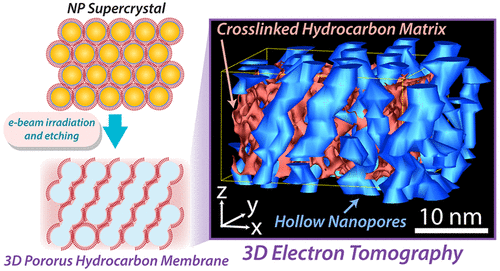当前位置:
X-MOL 学术
›
Nano Lett.
›
论文详情
Our official English website, www.x-mol.net, welcomes your feedback! (Note: you will need to create a separate account there.)
Ultrathin Porous Hydrocarbon Membranes Templated by Nanoparticle Assemblies
Nano Letters ( IF 10.8 ) Pub Date : 2020-12-10 , DOI: 10.1021/acs.nanolett.0c03450 Grayson L. Jackson 1 , Xiao-Min Lin 2 , Jotham Austin 3 , Jianguo Wen 2 , Heinrich M. Jaeger 1, 4
Nano Letters ( IF 10.8 ) Pub Date : 2020-12-10 , DOI: 10.1021/acs.nanolett.0c03450 Grayson L. Jackson 1 , Xiao-Min Lin 2 , Jotham Austin 3 , Jianguo Wen 2 , Heinrich M. Jaeger 1, 4
Affiliation

|
Porous polymer membranes are widely desired as catalyst supports, sensors, and active layers for separation membranes. We demonstrate that electron beam irradiation of freely suspended gold or Fe3O4 nanoparticle (NP) monolayer sheets followed by wet chemical etching is a high-fidelity strategy to template two-dimensional (2D) porous cross-linked hydrocarbon membranes. This approach, which relies on secondary electrons generated by the NP cores, can further be used to transform three-dimensional (3D) terraced gold NP supercrystals into 3D porous hydrocarbon membranes. We utilize electron tomography to show how the number of NP layers (monolayer to pentalayer) controls attenuation and scattering of the primary e-beam, which in turn determines ligand cross-link density and 3D pore structure. Electron tomography also reveals that many nanopores are vertically continuous because of preferential sintering of NPs. This work demonstrates new routes for the construction of functional nanoporous media.
中文翻译:

纳米组装体为模板的超薄多孔烃膜
多孔聚合物膜被广泛用作催化剂载体,传感器和用于分离膜的活性层。我们证明了自由悬浮金或Fe 3 O 4的电子束辐照纳米颗粒(NP)单层片材,然后进行湿法化学蚀刻,是对二维(2D)多孔交联烃膜进行模板化的高保真策略。这种依靠NP核产生的二次电子的方法,可以进一步用于将三维(3D)梯田金NP超晶转变为3D多孔烃膜。我们利用电子断层扫描来显示NP层(单层到五层)的数量如何控制主要电子束的衰减和散射,进而决定配体的交联密度和3D孔结构。电子断层扫描还显示,由于纳米粒子的优先烧结,许多纳米孔在垂直方向上是连续的。这项工作演示了功能纳米多孔介质的建设的新途径。
更新日期:2021-01-13
中文翻译:

纳米组装体为模板的超薄多孔烃膜
多孔聚合物膜被广泛用作催化剂载体,传感器和用于分离膜的活性层。我们证明了自由悬浮金或Fe 3 O 4的电子束辐照纳米颗粒(NP)单层片材,然后进行湿法化学蚀刻,是对二维(2D)多孔交联烃膜进行模板化的高保真策略。这种依靠NP核产生的二次电子的方法,可以进一步用于将三维(3D)梯田金NP超晶转变为3D多孔烃膜。我们利用电子断层扫描来显示NP层(单层到五层)的数量如何控制主要电子束的衰减和散射,进而决定配体的交联密度和3D孔结构。电子断层扫描还显示,由于纳米粒子的优先烧结,许多纳米孔在垂直方向上是连续的。这项工作演示了功能纳米多孔介质的建设的新途径。



























 京公网安备 11010802027423号
京公网安备 11010802027423号